Dual Anti-Inflammatory and Anticancer Activity of Novel 1,5-Diaryl Pyrazole Derivatives: Molecular Modeling, Synthesis, In Vitro Activity, and Dynamics Study
Abstract
:1. Introduction
2. Materials and Methods
2.1. Molecular Docking
2.2. ADMET and Drug-Likeness Filtration
2.3. MD Simulations
2.4. Binding Free-Energy Calculation
2.5. Chemical Synthesis
2.5.1. Chemicals and Solvents
2.5.2. General Procedure for the Synthesis of Compound a to d
2.5.3. General Procedure for the Synthesis of Compound e to h
2.5.4. General Procedure for the Synthesis of Compound i to l
2.5.5. General Procedure for the Synthesis of Compound T1 to T10
2.6. In Vitro Anti-Inflammatory Studies
2.6.1. Protein Denaturation Assay
2.6.2. In Vitro COX Enzymatic Assay
2.6.3. In Vitro Anticancer Activity
3. Results and Discussion
3.1. QSAR and Docking Studies
3.2. ADMET and Drug-Likeness Analysis
3.3. Synthesis of the Target Compounds
3.4. In Vitro Studies
3.4.1. Protein Denaturation Assay
3.4.2. In Vitro COX Inhibition Assay
3.4.3. COX Selectivity Index
3.4.4. In Vitro Anticancer Activity
3.5. MD Simulations Analysis
Free Energy Calculations (MM-PBSA)
4. Conclusions
Future Scope
Supplementary Materials
Author Contributions
Funding
Institutional Review Board Statement
Informed Consent Statement
Data Availability Statement
Acknowledgments
Conflicts of Interest
References
- Ong, C.K.S.; Lirk, P.; Tan, C.H.; Seymour, R.A. An evidence-based update on nonsteroidal anti-inflammatory drugs. Clin. Med. Res. 2007, 5, 19–34. [Google Scholar] [CrossRef]
- Higgins, C.B.; Braunwald, E. The prostaglandins biochemical, physiologic and clinical considerations. Am. J. Med. 1997, 53, 92–112. [Google Scholar] [CrossRef]
- Ricciotti, E.; Fitzgerald, G.A. Prostaglandins and inflammation. Arterioscler. Thromb. Vasc. Biol. 2011, 31, 986–1000. [Google Scholar] [CrossRef]
- Miller, S.B. Prostaglandins in health and disease: An overview. Semin. Arthritis Rheum. 2006, 36, 37–49. [Google Scholar] [CrossRef]
- Carullo, G.; Galligano, F.; Aiello, F. Structure-activity relationships for the synthesis of selective cyclooxygenase 2 inhibitors: An overview (2009–2016). Medchemcomm 2017, 8, 492–500. [Google Scholar] [CrossRef]
- El-Shoukrofy, M.S.; Abd El Razik, H.A.; AboulWafa, O.M.; Bayad, A.E.; El-Ashmawy, I.M. Pyrazoles containing thiophene, thienopyrimidine and thienotriazolopyrimidine as COX-2 selective inhibitors: Design, synthesis, in vivo anti-inflammatory activity, docking and in silico chemo-informatic studies. Bioorg. Chem. 2019, 85, 541–557. [Google Scholar] [CrossRef]
- Müller, N.; Strassnig, M.; Schwarz, M.J.; Ulmschneider, M.; Riedel, M. COX-2 inhibitors as adjunctive therapy in schizophrenia. Expert Opin. Investig. Drugs 2004, 13, 1033–1044. [Google Scholar] [CrossRef]
- Rawat, C.; Kukal, S.; Dahiya, U.R.; Kukreti, R. Cyclooxygenase-2 (COX-2) inhibitors: Future therapeutic strategies for epilepsy management. J. Neuroinflamm. 2019, 16, 197. [Google Scholar] [CrossRef]
- Minghetti, L. Cyclooxygenase-2 (COX-2) in inflammatory and degenerative brain diseases. J. Neuropathol. Exp. Neurol. 2004, 63, 901–910. [Google Scholar] [CrossRef]
- Pu, D.; Yin, L.; Huang, L.; Qin, C.; Zhou, Y.; Wu, Q.; Li, Y.; Zhou, Q.; Li, L. Cyclooxygenase-2 inhibitor: A potential combination strategy with immunotherapy in cancer. Front. Oncol. 2021, 11, 637504. [Google Scholar] [CrossRef]
- Regulski, M.; Regulska, K.; Prukała, W.; Piotrowska, H.; Stanisz, B.; Murias, M. COX-2 inhibitors: A novel strategy in the management of breast cancer. Drug Discov. Today 2016, 21, 598–615. [Google Scholar] [CrossRef]
- Mohammed, A.; Yarla, N.S.; Madka, V.; Rao, C.V. Clinically relevant anti-inflammatory agents for chemoprevention of colorectal cancer: New perspectives. Int. J. Mol. Sci. 2018, 19, 2332. [Google Scholar] [CrossRef]
- Li, S.; Jiang, M.; Wang, L.; Yu, S. Combined chemotherapy with cyclooxygenase-2 (COX-2) inhibitors in treating human cancers: Recent advancement. Biomed. Pharmacother. 2020, 129, 110389. [Google Scholar] [CrossRef]
- Liu, B.; Qu, L.; Yan, S. Cyclooxygenase-2 promotes tumor growth and suppresses tumor immunity. Cancer Cell Int. 2015, 5, 106. [Google Scholar] [CrossRef]
- Akhtar, W.; Marella, A.; Alam, M.M.; Khan, M.F.; Akhtar, M.; Anwer, T.; Khan, F.; Naematullah, M.; Azam, F.; Rizvi, M.A.; et al. Design and synthesis of pyrazole–pyrazoline hybrids as cancer-associated selective COX-2 inhibitors. Arch. Pharm. 2021, 354, 2000116. [Google Scholar] [CrossRef]
- Zhao, H.; Wu, L.; Yan, G.; Chen, Y.; Zhou, M.; Wu, Y.; Li, Y. Inflammation and tumor progression: Signaling pathways and targeted intervention. Signal Transduct. Target. Ther. 2021, 6, 263. [Google Scholar]
- Kavaliauskas, P.; Opazo, F.S.; Acevedo, W.; Petraitiene, R.; Grybaitė, B.; Anusevičius, K.; Mickevicius, V.; Belyakov, S.; Petraitis, V. Synthesis, Biological Activity, and Molecular Modelling Studies of Naphthoquinone Derivatives as Promising Anticancer Candidates Targeting COX-2. Pharmaceuticals 2022, 15, 541. [Google Scholar] [CrossRef]
- Priya, D.; Gopinath, P.; Dhivya, L.S.; Vijaybabu, A.; Haritha, M.; Senthilkumar, P.; Kathiravan, M.K. Structural insights into pyrazoles as agents against anti-inflammatory and related disorders. Chem. Sel. 2022, 7, e202104429. [Google Scholar] [CrossRef]
- Priya, D.; Kathiravan, M.K. Molecular insights into benzene sulphonamide substituted diarylpyrazoles as cyclooxygenase-2 inhibitor and its structural modifications. J. Biomol. Struct. Dyn. 2021, 39, 5093–5104. [Google Scholar] [CrossRef]
- Eberhardt, J.; Santos-Martins, D.; Tillack, A.F.; Forli, S. AutoDockVina 1.2.0: New docking methods, expanded force field, and python bindings. J. Chem. Inf. Model. 2021, 61, 3891–3898. [Google Scholar] [CrossRef]
- Cheng, F.; Li, W.; Zhou, Y.; Shen, J.; Wu, Z.; Liu, G.; Lee, P.W.; Tang, Y. AdmetSAR: A comprehensive source and free tool for assessment of chemical ADMET properties. J. Chem. Inf. Model. 2012, 52, 3099–3105. [Google Scholar] [CrossRef]
- Daina, A.; Michielin, O.; Zoete, V. SwissADME: A free web tool to evaluate pharmacokinetics, drug-likeness and medicinal chemistry friendliness of small molecules. Sci. Rep. 2017, 7, 42717. [Google Scholar] [CrossRef]
- Banerjee, P.; Eckert, A.O.; Schrey, A.K.; Preissner, R. ProTox-II: A webserver for the prediction of toxicity of chemicals. Nucleic Acids Res. 2018, 46, W257–W263. [Google Scholar] [CrossRef]
- Berendsen, H.J.C.; van der Spoel, D.; van Drunen, R. GROMACS: A message-passing parallel molecular dynamics implementation. Comput. Phys. Commun. 1995, 91, 43–56. [Google Scholar] [CrossRef]
- Kumari, R.; Kumar, R.; Lynn, A. G-Mmpbsa -A GROMACS tool for high-throughput MM-PBSA calculations. J. Chem. Inf. Model. 2014, 54, 1951–1962. [Google Scholar] [CrossRef]
- Lindorff-Larsen, K.; Piana, S.; Palmo, K.; Maragakis, P.; Klepeis, J.L.; Dror, R.O.; Shaw, D.E. Improved side-chain torsion potentials for the Amber Ff99SB protein force field. Proteins Struct. Funct. Bioinform. 2010, 78, 1950–1958. [Google Scholar] [CrossRef]
- Hess, B.; Bekker, H.; Berendsen, H.J.C.; Fraaije, J.G.E.M. LINCS: A linear constraint solver for molecular simulations. J. Comput. Chem. 1997, 18, 1463–1472. [Google Scholar] [CrossRef]
- BIOVIA, DassaultSystèmes. BIOVIA Workbook, Release 2021; BIOVIA Pipeline Pilot, Release 2021; Discovery Studio; DassaultSystèmes: San Diego, CA, USA, 2021. [Google Scholar]
- Schrödinger, L.; DeLano, W. The PyMOL Molecular Graphics System, Version 2.0; Schrödinger, LLC.: New York, NY, USA, 2020. [Google Scholar]
- Mosmann, T. Rapid colorimetric assay for cellular growth and survival: Application to proliferation and cytotoxicity assays. J. Immunol. Methods 1983, 65, 55–63. [Google Scholar] [CrossRef]
- Lu, X.Y.; Wang, Z.C.; Wei, T.; Yan, X.Q.; Wang, P.F.; Zhu, H.L. Design, synthesis and evaluation of benzenesulfonamide-substituted 1,5-diarylpyrazoles containing phenylacetohydrazide derivatives as COX-1/COX-2 agents against solid tumors. RSC Adv. 2016, 6, 22917–22935. [Google Scholar] [CrossRef]
- Mizushima, Y.; Kobayashi, M. Interaction of anti-inflammatory drugs with serum proteins, especially with some biologically active proteins. J. Pharm. Pharmacol. 1968, 20, 169–173. [Google Scholar] [CrossRef]
- Cuendet, M.; Mesecar, A.D.; DeWitt, D.L.; Pezzuto, J.M. An ELISA method to measure inhibition of the COX enzymes. Nat. Protoc. 2006, 1, 1915–1921. [Google Scholar] [CrossRef] [PubMed]
- Oniga, S.; Pacureanu, L.; Stoica, C.; Palage, M.; Crăciun, A.; Rusu, L.; Crisan, E.-L.; Araniciu, C. COX inhibition profile and molecular docking studies of some 2-(Trimethoxyphenyl)-Thiazoles. Molecules 2017, 22, 1507. [Google Scholar] [CrossRef] [PubMed]
- Halim, P.A.; Sharkawi, S.M.; Labib, M.B. Novel pyrazole-based COX-2 inhibitors as potential anticancer agents: Design, synthesis, cytotoxic effect against resistant cancer cells, cell cycle arrest, apoptosis induction and dual EGFR/Topo-1 inhibition. Bioorg. Chem. 2023, 131, 106273. [Google Scholar] [CrossRef] [PubMed]
- Sodde, V.K.; Lobo, R.; Kumar, N.; Maheshwari, R.; Shreedhara, C.S. Cytotoxic activity of Macrosolenparasiticus (L.) Danser on the growth of breast cancer cell line (MCF-7). Pharmacogn. Mag. 2015, 11 (Suppl. S1), S156. [Google Scholar]
- Singh, R.; Bhardwaj, V.K.; Das, P.; Bhattacherjee, D.; Zyryanov, G.V.; Purohit, R. Benchmarking the ability of novel compounds to inhibit SARS-CoV-2 main protease using steered molecular dynamics simulations. Comput. Biol. Med. 2022, 146, 105572. [Google Scholar] [CrossRef]

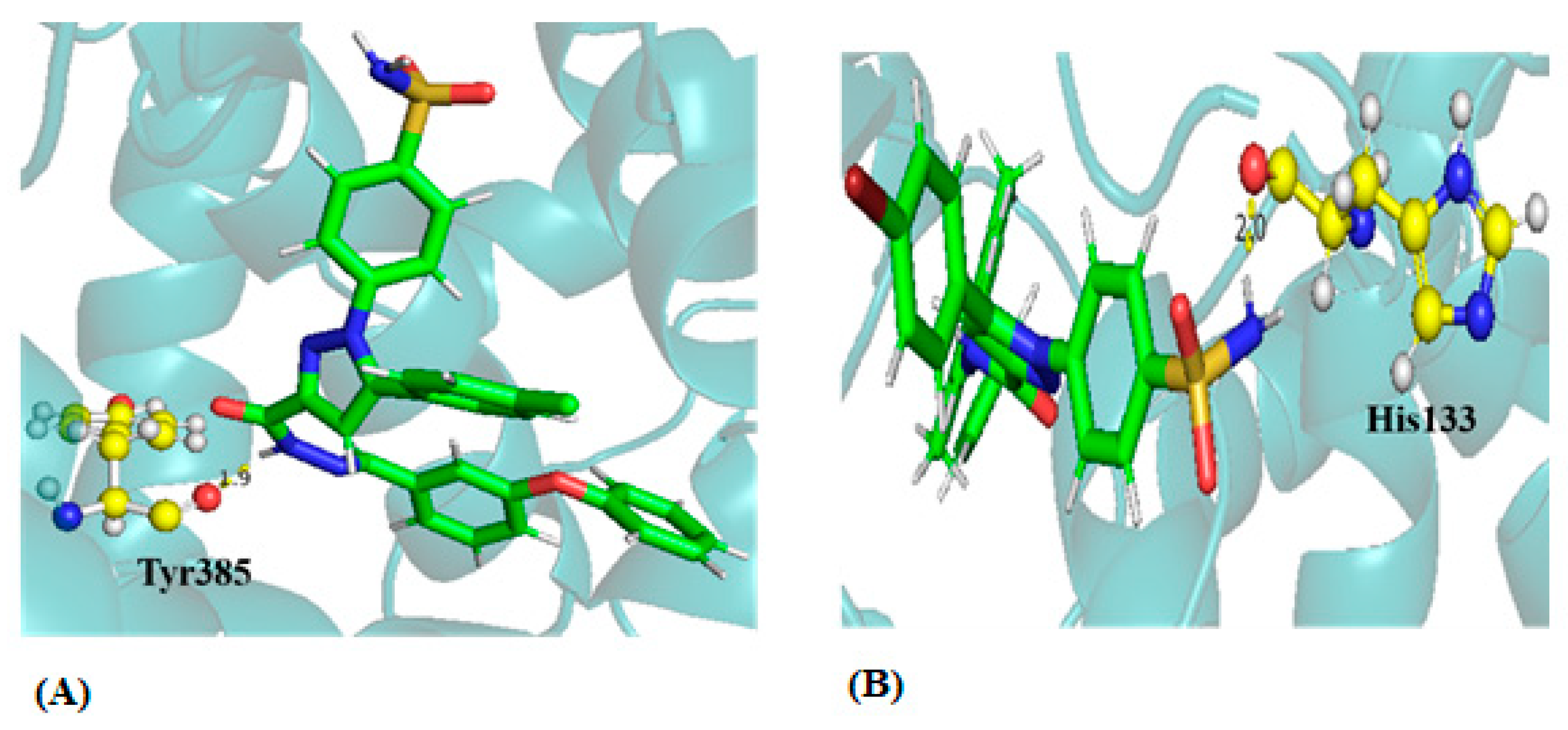
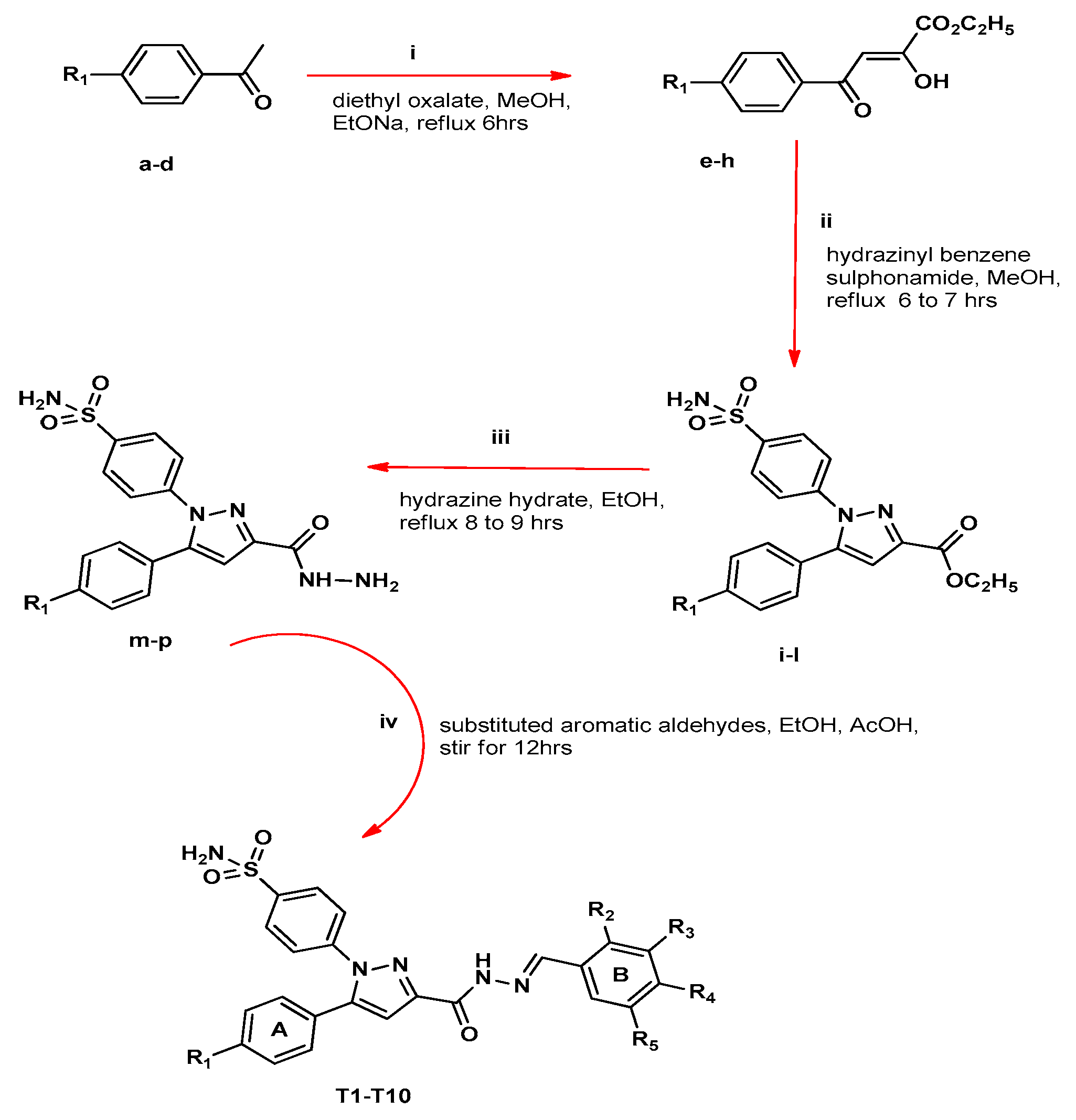

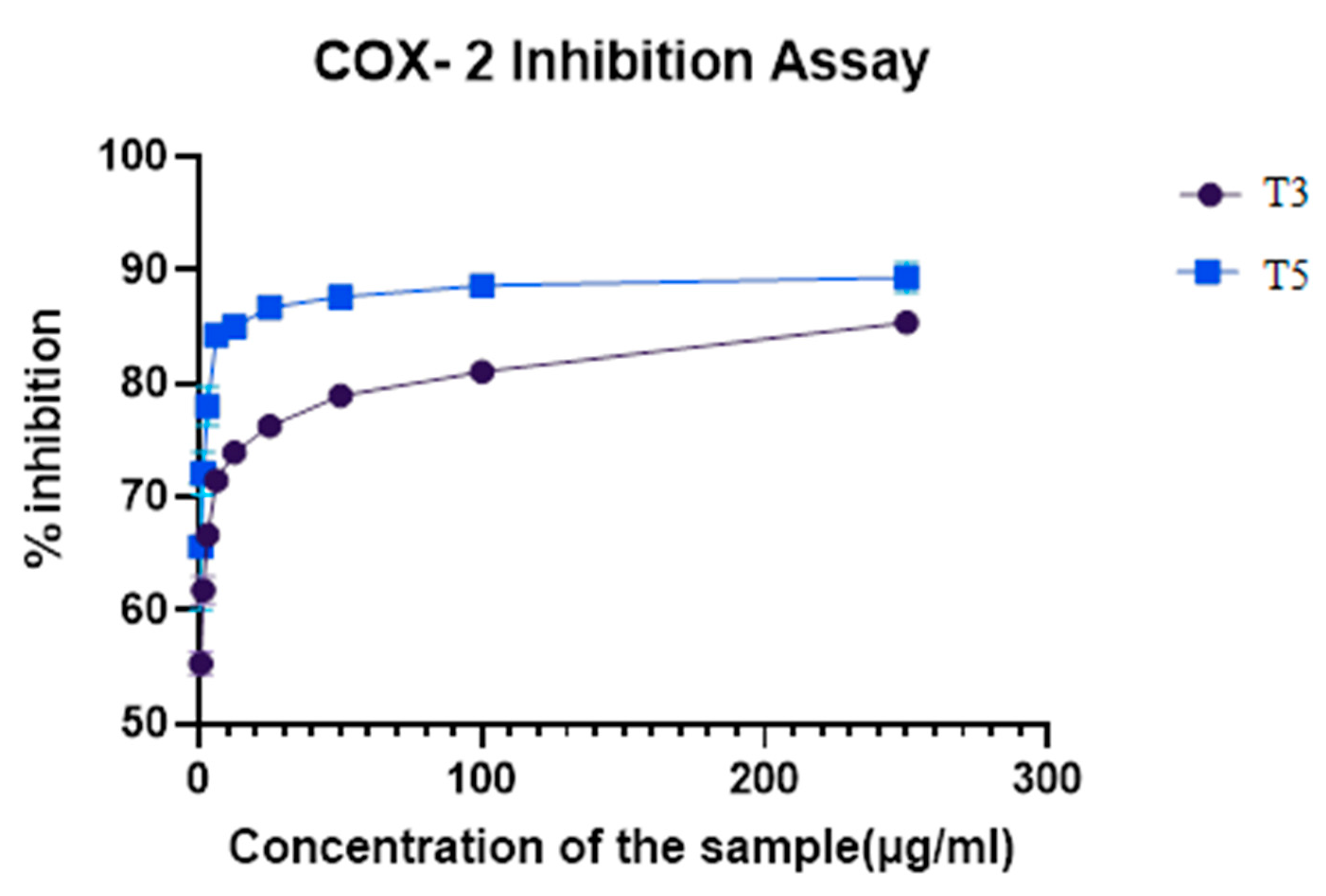

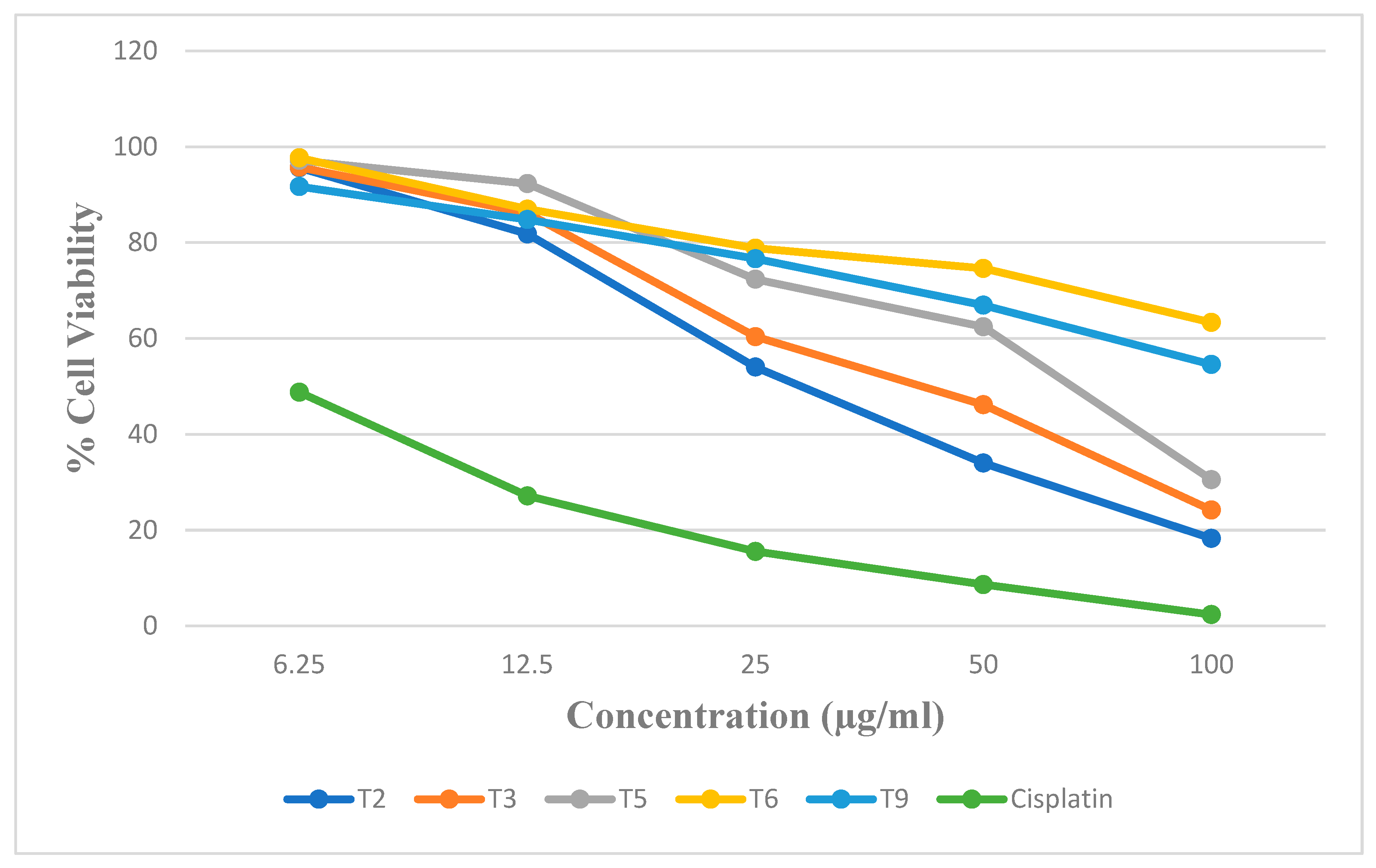
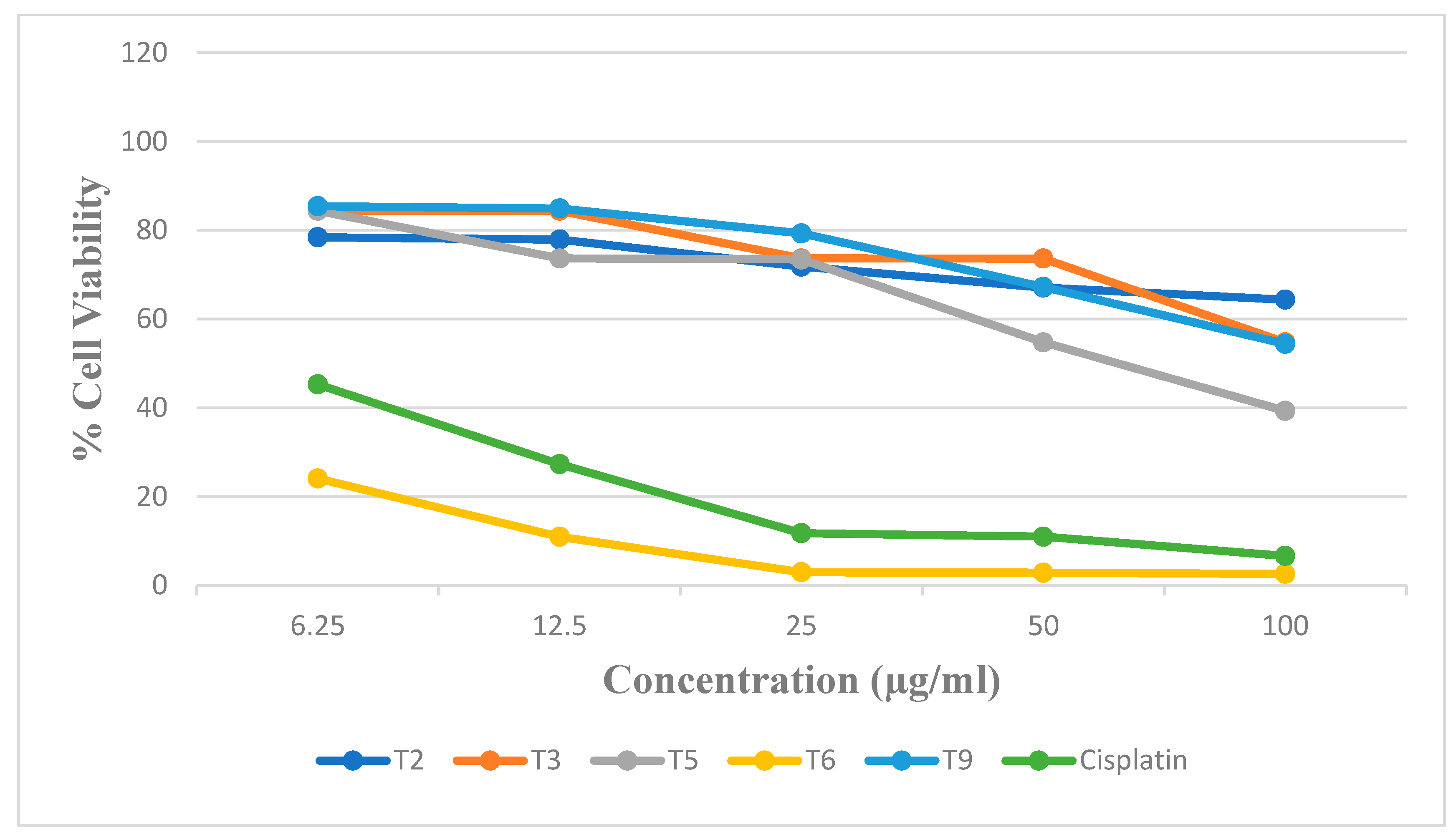


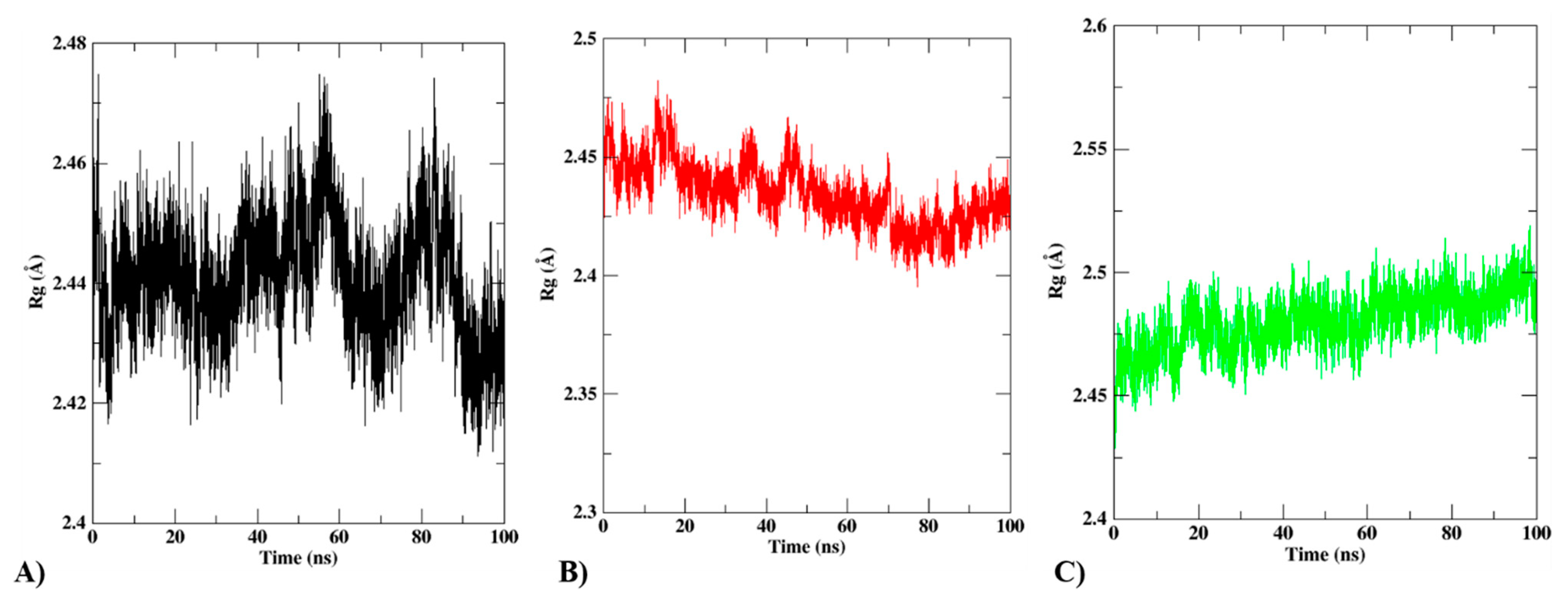

| Compound | Binding Energy in kcal/mol | Amino Acid Residues |
|---|---|---|
| T1 | −9.74 | ARG120, CYS36, ASP125 |
| T2 | −10.08 | LYS333, GLY235, GLY225 |
| T3 | −10.20 | THR212, TYR385, LYS211, GLN289 |
| T4 | −10.18 | GLN374 |
| T5 | −10.80 | ASP325, GLU326, HIS133 |
| T6 | −10.12 | ASN34, GLY526 |
| T7 | −10.02 | GLU465 |
| T8 | −10.02 | SER126, ARG44, ARG120 |
| T9 | −10.04 | ARG120, TYR130, ASP125 |
| T10 | −9.69 | ARG120, PRO86, TYR115 |
| Celecoxib | −10.16 | ALA527, GLY526, MET522, ARG120 |
| Compound | R1 | R2 | R3 | R4 | R5 |
|---|---|---|---|---|---|
| T1 | OCH3 | H | OC6H5 | H | H |
| T2 | OCH3 | H | H | OC6H5 | H |
| T3 | Cl | H | OC6H5 | H | H |
| T4 | Br | H | OC6H5 | H | H |
| T5 | Br | H | CH3 | OCH2C6H5 | CH3 |
| T6 | Cl | H | CH3 | OCH2C6H5 | CH3 |
| T7 | Br | H | H | OC6H5 | H |
| T8 | Cl | H | H | OC6H5 | H |
| T9 | Br | OH | H | Cl | H |
| T10 | H | OH | H | Cl | H |
| Compound | COX-2 IC50(µM) | COX-1 IC50(µM) | Selectivity Index |
|---|---|---|---|
| T2 | 12 | -- | -- |
| T3 | 0.781 | 4.655 | 5.960 |
| T5 | 0.781 | 5.596 | 7.165 |
| T6 | 1.562 | -- | -- |
| T9 | 3.5 | -- | -- |
| Celecoxib | 0.3 | -- | -- |
| Compounds | vdWs | Ele | Pol | SASA | Average Binding Energy in (kcal mol−1) |
|---|---|---|---|---|---|
| Compound-T3 | −56.12 | −16.66 | 58.10 | −5.58 | −20.26 ± 5.01 |
| Compound-T5 | −54.07 | −1.58 | 28.77 | −5.67 | −32.55 ± 3.96 |
Disclaimer/Publisher’s Note: The statements, opinions and data contained in all publications are solely those of the individual author(s) and contributor(s) and not of MDPI and/or the editor(s). MDPI and/or the editor(s) disclaim responsibility for any injury to people or property resulting from any ideas, methods, instructions or products referred to in the content. |
© 2024 by the authors. Licensee MDPI, Basel, Switzerland. This article is an open access article distributed under the terms and conditions of the Creative Commons Attribution (CC BY) license (https://creativecommons.org/licenses/by/4.0/).
Share and Cite
Deivasigamani, P.; Rubavathy, S.M.E.; Jayasankar, N.; Saravanan, V.; Thilagavathi, R.; Prakash, M.; Selvam, C.; Rajagopal, R.; Alfarhan, A.; Kathiravan, M.K.; et al. Dual Anti-Inflammatory and Anticancer Activity of Novel 1,5-Diaryl Pyrazole Derivatives: Molecular Modeling, Synthesis, In Vitro Activity, and Dynamics Study. Biomedicines 2024, 12, 788. https://doi.org/10.3390/biomedicines12040788
Deivasigamani P, Rubavathy SME, Jayasankar N, Saravanan V, Thilagavathi R, Prakash M, Selvam C, Rajagopal R, Alfarhan A, Kathiravan MK, et al. Dual Anti-Inflammatory and Anticancer Activity of Novel 1,5-Diaryl Pyrazole Derivatives: Molecular Modeling, Synthesis, In Vitro Activity, and Dynamics Study. Biomedicines. 2024; 12(4):788. https://doi.org/10.3390/biomedicines12040788
Chicago/Turabian StyleDeivasigamani, Priya, S. M. Esther Rubavathy, Narayanan Jayasankar, Venkatesan Saravanan, Ramasamy Thilagavathi, Muthuramalingam Prakash, Chelliah Selvam, Rajakrishnan Rajagopal, Ahmed Alfarhan, Muthu Kumaradoss Kathiravan, and et al. 2024. "Dual Anti-Inflammatory and Anticancer Activity of Novel 1,5-Diaryl Pyrazole Derivatives: Molecular Modeling, Synthesis, In Vitro Activity, and Dynamics Study" Biomedicines 12, no. 4: 788. https://doi.org/10.3390/biomedicines12040788









